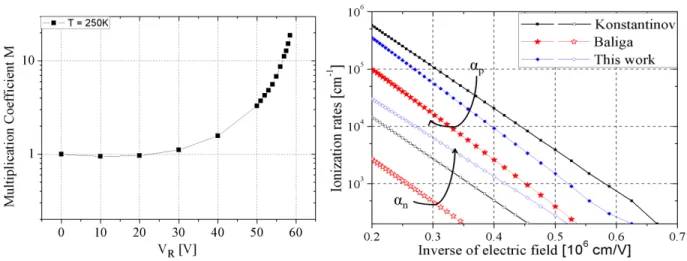HAL Id: hal-02133683
https://hal.archives-ouvertes.fr/hal-02133683
Submitted on 27 May 2019
HAL is a multi-disciplinary open access
archive for the deposit and dissemination of sci-entific research documents, whether they are pub-lished or not. The documents may come from teaching and research institutions in France or abroad, or from public or private research centers.
L’archive ouverte pluridisciplinaire HAL, est destinée au dépôt et à la diffusion de documents scientifiques de niveau recherche, publiés ou non, émanant des établissements d’enseignement et de recherche français ou étrangers, des laboratoires publics ou privés.
Temperature Dependence of 4H-SiC Ionization Rates
Using Optical Beam Induced Current
Hassan Hamad, Christophe Raynaud, Pascal Bevilacqua, Sigo Scharnholz,
Dominique Planson
To cite this version:
Hassan Hamad, Christophe Raynaud, Pascal Bevilacqua, Sigo Scharnholz, Dominique Planson. Tem-perature Dependence of 4H-SiC Ionization Rates Using Optical Beam Induced Current. ECSCRM’14, Sep 2014, Grenoble, France. pp.MO2-IP-08. �hal-02133683�
Temperature dependence of 4H-SiC ionization rates using Optical Beam
Induced Current
Hassan Hamad
1, Christophe Raynaud
1, Pascal Bevilacqua
1, Sigo Scharnholz
2, Dominique
Planson
11
Univ Lyon, INSA Lyon, Laboratoire Ampère, 21 Avenue Jean Capelle, 69621
Villeurbanne Cedex, France.
2
French-German Research Institute of Saint-Louis (ISL), 5 rue du Général Cassagnou,
68301 Saint-Louis Cedex, France
hassan.hamad@insa-lyon.fr
The behavior of the power components designed with the silicon carbide 4H-SiC in environments with varying temperature is a key parameter indicating their reliability. This paper shows the dependence of the ionization rates of 4H-SiC with respect to the temperature. Ionization rates are not too widely studied and the results already found are, more or less, dispersed [1-3]. Their determination helps predict more accurately the critical electric field and hence the breakdown voltage. Studying the ionization rates under varying temperatures allows the design of high breakdown voltages components under different temperature conditions. The method involves using an optical beam with appropriate wavelength to light perpendicularly a reverse biased PN junction. The photon absorption leads to the generation of electron-hole pairs (EHPs) that may or may not be submitted to an electric field depending on the depth at which they are created. EHPs created in the space charge region (SCR) will be accelerated, and thus an induced current is measured hence the naming of the method: Optical Beam Induced Current (OBIC) as shown in fig. 1. For voltages near the breakdown voltage, the electric field becomes high, the EHPs gain a kinetic energy and collide with the atoms in the crystalline structure leading to the generation of a new EHPs, which in turns may lead to the creation of new EHPs; this is manifested by an increase of the OBIC signal. The multiplication coefficient is defined as the ratio between the induced current at a given voltage and at 0 V (where there is no multiplication). The ionization coefficients curves are derived from the multiplication curves.
The measurements are realized on circular avalanche diodes protected with MESA etching and having a breakdown voltage of 59V. At the center of the diode, an optical window is located allowing the optical beam to penetrate into the SCR (fig. 2) [4]. A pulsed UV laser with a wavelength of 349 nm is used to generate the EHPs. The pulse energy can be adjusted up to 120 µJ. The pulse duration varies between 3 and 7ns according to frequency and pulse energy (fig. 3).
The laser beam is scanned along the diameter of the diode to measure the OBIC signal. The measurement is done between 200 K and 400 K temperatures with a step of 25 K. In addition, for each temperature value the voltage is scanned up to the breakdown voltage. Fig. 4 shows the OBIC signal vs. the beam position for several reverse voltages at 250K. Fig. 5a shows the multiplication ratio vs. the voltage at 250K and fig. 5b shows the ionization rates vs. the inverse of the electric field at the same temperature. More results showing the variation of ionization rates vs. temperature will be published in the final paper. Studying these variations allows determining the dependence law between ionization rates and the temperature variation.
[1] A-O. Konstantinov, Q. Wahab, N. Nordell, U. Lindefelt, Materials Science Forum, vols. 264-268, 513 (1998).
[2] R. Raghunathan, B-J. Baliga, Solid State Electronics, vol. 43, 199 (1999).
[3] D-M. Nguyen, C. Raynaud, M. Lazar, G. Pâques, S. Scharnholz, N. Dheilly, D. Tournier, D. Planson, Materials Science Forum, vols. 717-720, 545 (2012)
[4] M. Lazar, F. Jomard, D-M. Nguyen, C. Raynaud, G. Pâques, S. Scharnholz, D. Tournier, D. Planson, Materials Science Forum, vols. 717-720, 885 (2012).
Fig. 1: Schematic view of OBIC principle.
Fig. 2: Cross section view of avalanche diode.
Fig. 3: Schematic view of OBIC bench.
Figure 4: OBIC signal vs. Beam position forseveral revese voltages at 250K.
Fig. 5: (a) Curve of multiplication coefficient vs. Reverse voltage at 250K, (b) Ionization rates of 4H-SiC vs. the inverse of electric field at 250K for this work.
